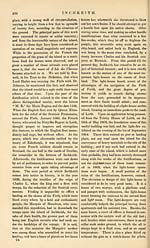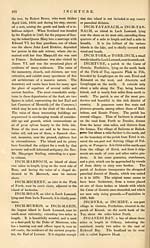Gazetteer of Scotland > Volume 2
(87) Page 571
Download files
Complete book:
Individual page:
Thumbnail gallery: Grid view | List view

I N C H K E I T H.
571
where they have a guard-bed and fire-place.
The establishment is in all respects very com-
plete. Besides good salaries, the principal and
his assistants have ten acres of the island en-
closed, and a garden, which they possess or hold
in common, with a sufficient allowance of coal
and oil for family use. In justice to these per-
sons, we have to state, that at all times they
display the utmost politeness in showing the
interior of the light-house to strangers. When
the present light-house was completed, it was
what seamen call a stationary or fixed light,
and contained sixteen reflectors, made upon the
parabolic curve, formed of copper, strongly
coated or plated with silver, instead of the
hollow or cavity of the reflector being lined
with facets of mirror glass as formerly. Inch-
keith light remained as a stationary light till the
year 1815, the period when the light of the isle
of May was altered from an open coal fire to a
stationary light, with oil and reflectors; on
which it became necessary to alter the charac-
ter of Inchkeith light from a stationary to a
revolving light ; and with this alteration, that
seven reflectors, instead of the former number,
are now found perfectly sufficient. The ma-
chinery for making the light revolve, consists
of a movement, or piece of strong clock-work,
kept in motion by a weight, and curiously fitted
with two governors, upon the plan of the
steam-engine, instead of a fly wheel. The
reflectors are ranged upon a horizontal frame,
which is made to revolve periodically upon a
perpendicular axis, exhibiting, to a distant ob-
server, the alternate effect of light and dark-
ness, in a very beautiful and simple manner.
The reflectors are brought round in succession
to the eye of the observer, and the angles, or
interstices between them, produce the effect
of darkness, by which this light is distinguished
from the light of the isle of May, and also
from the common surrounding lights on the
opposite shores. The light has further the
advantage of being elevated above the medium
level of the sea about 235 feet ; and such is
the powerful effect of the reflecting apparatus,
that it is distinctly seen in a favourable state of
the atmosphere, at the distance of four or five
leagues, although it is impossible that more
than a single reflector can be seen at a time.*
* Edin. Encv., article Inchkeith, written, we believe,
by Mr. Robert Stevenson, civil engineer, to which we
have to acknowledge considerable obligations in the above
description of the island.
The mechanism which moves the lights is ex-
ceedingly beautiful, and is kept in the highest
order. To examine it as a matter of curiosity,
or to view the island, the place is often visited
by boating parties from the Edinburgh side of
the fhrth, and it is generally selected by the
Highland Club as a fit theatre whereon to ex-
hibit their annual Olympic games. On this
gala occasion, the island is crowded with ladies
and gentlemen, who arrive in steam vessels to
witness the pastimes. The island is now the
property of the Buccleugh family.
INCH-KENNETH, an islet of the He-
brides, lying betwixt Mull and Icolmkill, and
possessing the ruins of a small religious esta-
blishment, once dependant on the adjacent is-
land.
INCH-LOANAG, an island in Loch Lo-
mond, of about a mile in length, being that ly-
ing furthest to the north, in the lower or wide
part of the lake. It is celebrated for its yew-
trees, which, during the period when the bow
was in use in warfare, were of great considera-
tion and value.
INCHMAHOME, anciently INSCHE-
MACHAME, an island of great historical
and antiquarian interest in the lake of Men-
teith in Perthshire, extending to the compass
of about five acres, and forming now a varied
wilderness of forest and fruit-trees, interspersed
with underwood, and chequered with moss-
grown ruins. Adjacent to it on the west, lies
the islet of Talla, where are still to be traced
the ruins of a castle, which was the principal
seat of the Grahams, Earls of Menteith, a peer-
age now dormant. At a very early period, the
island of Inchmahome became the residence
of some religious recluses, and in the year
1238, the Pope granted to Walter Cumyine,
Earl of Menteath, liberty to erect upon it a
priory or abbey, for the reception of canons-
regular of the order of St. Augustine, in con-
nexion with the abbey of Cambuskenneth. It
was afterwards united by King James IV. to
his royal chapel of Stirling. Subsequently, it
was separated from this chapel, and bestowed
by King James V. upon John Lord Erskine,
who became commendatory abbot. Accord-
ing to returns made to government in 1562,
the annual profits of the priory were L.234 in
money, besides certain quantities of grain.
The house had four chapels dependant upon
it. The island of Inchmahome was visited by
several distinguished royal personages ; amoiy
571
where they have a guard-bed and fire-place.
The establishment is in all respects very com-
plete. Besides good salaries, the principal and
his assistants have ten acres of the island en-
closed, and a garden, which they possess or hold
in common, with a sufficient allowance of coal
and oil for family use. In justice to these per-
sons, we have to state, that at all times they
display the utmost politeness in showing the
interior of the light-house to strangers. When
the present light-house was completed, it was
what seamen call a stationary or fixed light,
and contained sixteen reflectors, made upon the
parabolic curve, formed of copper, strongly
coated or plated with silver, instead of the
hollow or cavity of the reflector being lined
with facets of mirror glass as formerly. Inch-
keith light remained as a stationary light till the
year 1815, the period when the light of the isle
of May was altered from an open coal fire to a
stationary light, with oil and reflectors; on
which it became necessary to alter the charac-
ter of Inchkeith light from a stationary to a
revolving light ; and with this alteration, that
seven reflectors, instead of the former number,
are now found perfectly sufficient. The ma-
chinery for making the light revolve, consists
of a movement, or piece of strong clock-work,
kept in motion by a weight, and curiously fitted
with two governors, upon the plan of the
steam-engine, instead of a fly wheel. The
reflectors are ranged upon a horizontal frame,
which is made to revolve periodically upon a
perpendicular axis, exhibiting, to a distant ob-
server, the alternate effect of light and dark-
ness, in a very beautiful and simple manner.
The reflectors are brought round in succession
to the eye of the observer, and the angles, or
interstices between them, produce the effect
of darkness, by which this light is distinguished
from the light of the isle of May, and also
from the common surrounding lights on the
opposite shores. The light has further the
advantage of being elevated above the medium
level of the sea about 235 feet ; and such is
the powerful effect of the reflecting apparatus,
that it is distinctly seen in a favourable state of
the atmosphere, at the distance of four or five
leagues, although it is impossible that more
than a single reflector can be seen at a time.*
* Edin. Encv., article Inchkeith, written, we believe,
by Mr. Robert Stevenson, civil engineer, to which we
have to acknowledge considerable obligations in the above
description of the island.
The mechanism which moves the lights is ex-
ceedingly beautiful, and is kept in the highest
order. To examine it as a matter of curiosity,
or to view the island, the place is often visited
by boating parties from the Edinburgh side of
the fhrth, and it is generally selected by the
Highland Club as a fit theatre whereon to ex-
hibit their annual Olympic games. On this
gala occasion, the island is crowded with ladies
and gentlemen, who arrive in steam vessels to
witness the pastimes. The island is now the
property of the Buccleugh family.
INCH-KENNETH, an islet of the He-
brides, lying betwixt Mull and Icolmkill, and
possessing the ruins of a small religious esta-
blishment, once dependant on the adjacent is-
land.
INCH-LOANAG, an island in Loch Lo-
mond, of about a mile in length, being that ly-
ing furthest to the north, in the lower or wide
part of the lake. It is celebrated for its yew-
trees, which, during the period when the bow
was in use in warfare, were of great considera-
tion and value.
INCHMAHOME, anciently INSCHE-
MACHAME, an island of great historical
and antiquarian interest in the lake of Men-
teith in Perthshire, extending to the compass
of about five acres, and forming now a varied
wilderness of forest and fruit-trees, interspersed
with underwood, and chequered with moss-
grown ruins. Adjacent to it on the west, lies
the islet of Talla, where are still to be traced
the ruins of a castle, which was the principal
seat of the Grahams, Earls of Menteith, a peer-
age now dormant. At a very early period, the
island of Inchmahome became the residence
of some religious recluses, and in the year
1238, the Pope granted to Walter Cumyine,
Earl of Menteath, liberty to erect upon it a
priory or abbey, for the reception of canons-
regular of the order of St. Augustine, in con-
nexion with the abbey of Cambuskenneth. It
was afterwards united by King James IV. to
his royal chapel of Stirling. Subsequently, it
was separated from this chapel, and bestowed
by King James V. upon John Lord Erskine,
who became commendatory abbot. Accord-
ing to returns made to government in 1562,
the annual profits of the priory were L.234 in
money, besides certain quantities of grain.
The house had four chapels dependant upon
it. The island of Inchmahome was visited by
several distinguished royal personages ; amoiy
Set display mode to: Large image | Transcription
Images and transcriptions on this page, including medium image downloads, may be used under the Creative Commons Attribution 4.0 International Licence unless otherwise stated. ![]()
| Gazetteers of Scotland, 1803-1901 > Gazetteer of Scotland > Volume 2 > (87) Page 571 |
|---|
| Permanent URL | https://digital.nls.uk/97431866 |
|---|
| Description | Volume II: Glenbanchor to Zetland. |
|---|---|
| Attribution and copyright: |
|
| Description | By Robert Chambers and William Chambers. Glasgow: Blackie & Son, 1838. 2 volumes. |
|---|---|
| Shelfmark | NF.1461.g.7 |
| Additional NLS resources: | |

